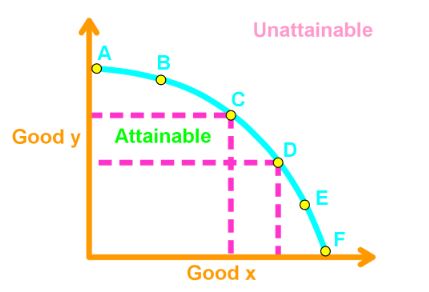PPF represents all possible choices of production for a business, or an economy. The PPF shows the limits to the production of two specific goods, when given the available resources and technology.
Production Efficiency: Is achieved when the production of goods and services are at the lowest possible cost.

Key ideas to note in a PPF:
- There is always a tradeoff along the PPF. (Opportunity Cost)
- Points outside the curve are unattainable.
- We achieve production efficiency when the point is on the curve
- When a point is inside the curve, this is product inefficient.
Opportunity Cost: is the benefit, profit, or value of something that must be given up to acquire something else.
Note: Opportunity Cost is a ratio between the decrease in quantity of a good and an increase in quantity of another good along the PPF.






